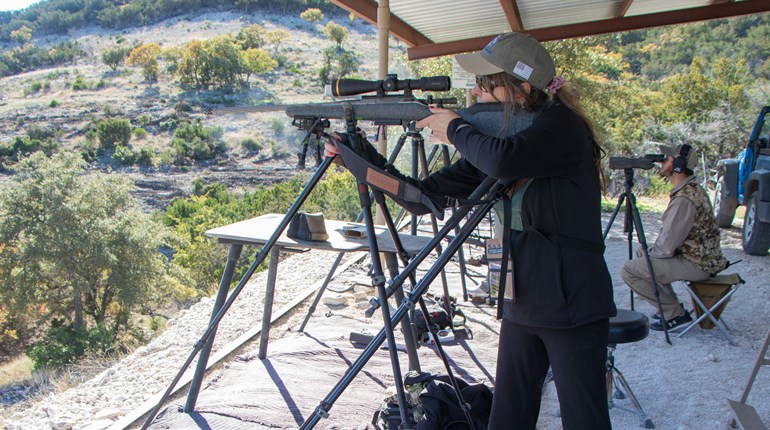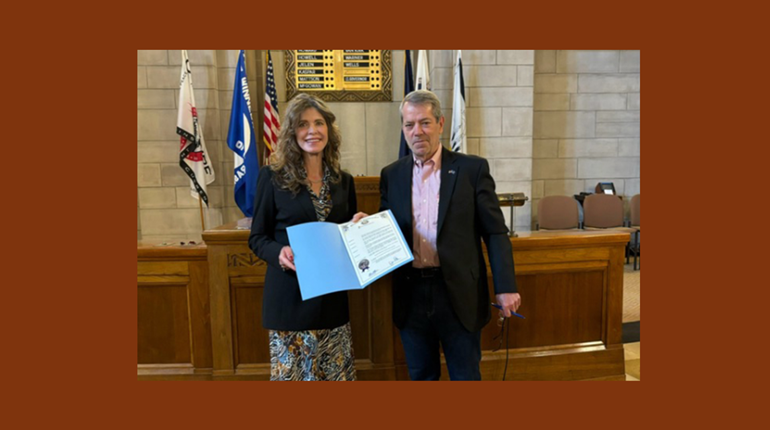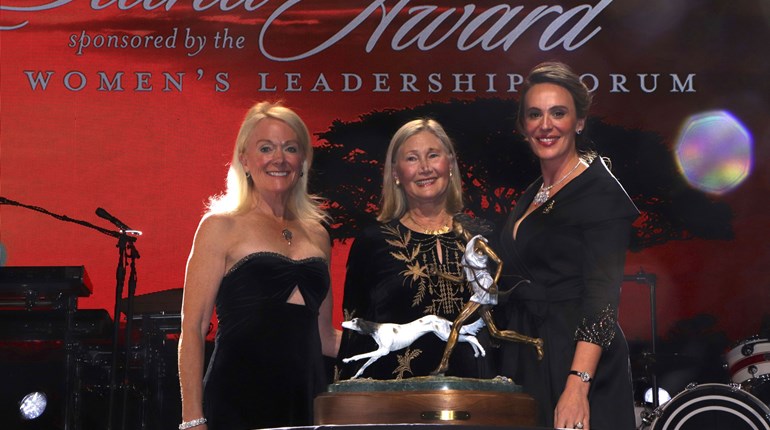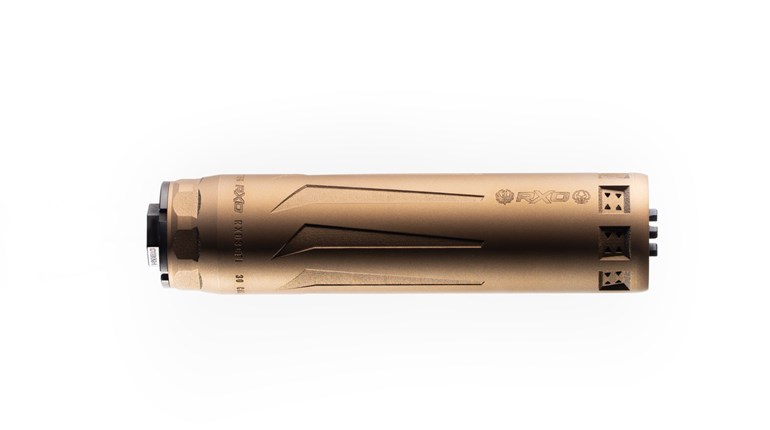“Surveys show more than half our readers are bowhunters,” I said to TV host and hunting guide Phil Phillips at the 2010 SHOT Show. I badly wanted to get in the bowhunting game. Knowing Phil regularly racked up archery bucks and had access to prime whitetail ground, I was angling for a project that warranted an invitation to hunt Phil’s Kansas lease.
I said, “If you get me into bowhunting and help me get a buck, I’ll mention you in my article,” knowing he’d have the hard part.
“Karen, we’ve known each other 15 years,” he said. “I don’t care about an article, and of course I’ll help you.”
“And you don’t have to worry about me messing up the hunt because I don’t get buck fever,” I replied.
“Really?” he asked. “We’ll see. You’ve also never bowhunted.”
Ten months and countless hours of practice later, in October 2010, my Mathews Z-7 and I were on a plane to Kansas.
“Really?” I asked as we drove around the property mid-morning checking photos on trail-cams. “You expect a mature whitetail buck to walk by this tree—the only tree in the field—when there’s all that brush along the river?”
“Welcome to western Kansas,” Phil said. “I’ve taken two of my best bucks from this cottonwood. In fact, I think we’ll sit here this evening and see if you can get your first archery buck.”
Two hours later, I was climbing that tree. Phil was the birdie perched two branches above, video camera hooked to the tree arm so he could film my hunt for “Phil Phillips Unleashed” on the Sportsman Channel. I surveyed the wide-open space, doubting a big buck would ever come here before dark. I flung a practice arrow at a cow bone 15 yards to my right and settled in. Not 10 minutes later I saw a giant 150-class 8-point trailing a doe 50 yards to my left, heading right to me. They’d popped straight out of the ground.
“Let him get to your right,” Phil whispered, knowing that’s the left-hander’s wheelhouse. But like any seasoned rifle hunter, I’d act quickly and take the first shot I knew I could make—only I was shooting a bow. The buck got in front of me and I drew. I wasn’t even in the right shooting position and got hung up at half-draw. I froze, locking eyes with the buck. I’d blown it. He and the doe turned back, leaving me gaping at how far his rack spread outside his ears. Seems I’d forgotten to plan the drawing sequence before drawing. My first hard lesson learned. Had I waited for him to get past me, I would have had a 15-yard cow-bone shot. Phil didn’t have much to say. Later, he explained there are so many rolls in the prairie that the deer can stay hidden until they come over the rise.
I recalled the chickens I’d counted the evening before. I’d arrived just in time to meet Phil’s friend Mike Williams, who was heading home to Mississippi after dropping a nice muley buck with his bow. During Mike’s rundown of the whitetails I’d see, we were losing daylight so Phil said to grab my Scent-Lok and we’d try filling my doe tag to break the ice. We headed for a ground blind where a number of mature does were crossing. Just before sunset I took my first archery deer—a mature 160-pounder—with an Easton FMJ arrow and NAP’s appropriately named HellRazor broadhead.
Then Phil got a text from buddy Steve Brazda, who’d dropped the 10-point he’d been hunting a half-mile away. “Wow, bowhunting doesn’t seem so difficult,” I said, anticipating my own chance at a buck. I’d soon learn it’s easy only when it works.
The next several days revealed many more bucks larger than my big 8-point on trail-cams and in the High Plains. Despite appearing open and treeless, Kansas deer habitat has great spots but they’re spread out. Viewing countless bucks even at rifle ranges provided me seasons of antler- and age-class field-judging experience. The trick was remembering how their 300-pound bodies made racks appear smaller, especially when I was used to hunting smaller subspecies in states like Maryland where I grew up. My Kansas doe weighed the same as some Maryland bucks. Knowing the guys had a 41/2-year-old-plus age requirement, I let several big young bucks walk, studying them closely and imagining what they’d be next year.
After seeing several bucks in the distance that made for such easy rifle shots, I welcomed the bowhunting challenge. I hoped for one of the larger ones. Who wouldn’t when the “small” one in your binocular is an 8! But the trip ended too soon. Steve and I left Phil to chase a near-200-inch 10-point he called “The Giant” he’d seen only once the previous season and once again before I arrived. He never saw it again but he did drop a 165-inch 9-point. Everyone earned an “A” in buck hunting except me.
■■■
Keeping tabs on my progress, Mike invited me to join the guys to hunt his property on Mississippi’s famed Big Black River in January 2011. Bucks there don’t grow quite as large as they do in Kansas, but for a southern strain of whitetails it’s as good as it gets.
The weather down south was refreshingly mild as I climbed another tree with Phil and his  video camera. To the right I caught antlers filtering toward me at 85 yards—tall tines, beams outside the ears. I clutched my Z-7, in tune with the buck’s every step. For agonizing minutes, he’d move and my adrenaline surged; he’d stop, I’d recover. Then something odd happened: My knees shook, my heart raced, I couldn’t breathe and I felt nauseous—simultaneously. I have buck fever, I thought. I’d never felt more alive, yet I couldn’t function in my nervous excitement. I recalled Phil’s words: “But you’ve never shot a buck with a bow before.” And then came the variables. Would I implode? Would the buck stop in range? What if I had no opening? Could I range the deer, set my sight and draw without being seen or heard?
video camera. To the right I caught antlers filtering toward me at 85 yards—tall tines, beams outside the ears. I clutched my Z-7, in tune with the buck’s every step. For agonizing minutes, he’d move and my adrenaline surged; he’d stop, I’d recover. Then something odd happened: My knees shook, my heart raced, I couldn’t breathe and I felt nauseous—simultaneously. I have buck fever, I thought. I’d never felt more alive, yet I couldn’t function in my nervous excitement. I recalled Phil’s words: “But you’ve never shot a buck with a bow before.” And then came the variables. Would I implode? Would the buck stop in range? What if I had no opening? Could I range the deer, set my sight and draw without being seen or heard?
The buck stopped at 23 yards. I drew back and launched an arrow—harmlessly over the buck’s back. I glanced down to see my TruGlo sight was still on 30 yards after shooting my practice arrows at the house. The buck lunged then stopped—a second chance.
I nocked another Easton “bullet” and moved my sight to 20. As I drew, the buck took a few steps, angling toward me, and froze. No way was I chancing being seen letting down and drawing again so I held my position, resting the bow cam on my right knee for support. The buck turned broadside. Perfect. Stealthily and confidently, I’d smoked the fundamentals. Then my arrow pounded into the ground. Seems I’d forgotten to lift the cam off my knee.
Mississippi permits shooting a deer a day but I couldn’t get a deer a season. Phil later confirmed the buck was in the solid 140s—a great buck for Mississippi, or anywhere. Rather than give up the game (it crossed my mind), I remembered archery great Fred Bear’s famous quote: “There’s more fun in hunting with the handicap of the bow than hunting with the sureness of the gun.” I’d forgotten.
■■■
I craved another crack at a buck. I had until April 30 to apply for my 2011 Kansas nonresident either-sex whitetail “round two” tag. Come November I’d be spending Thanksgiving in whitetail camp so I should hit the rut just right. Phil arrived ahead of us and dropped “The Giant,” the buck he’d sought the previous two years, on day one of season three—59 days into his three-year quest. I was happy he’d filled his tag because I knew he’d work hard to help me fill mine.
Kansas was in its second year of drought, yet still I was surprised when I saw the Arkansas River—or where it used to flow. How could a river be dry?
Seeing how drought affects antler size as Phil noted his giant had shrunk a bit each year from when he’d first seen him (the buck was only 51/2 years old when he was taken), I imagined the damage two mature rutting bucks could do to their antlers in battle. Every day unveiled a new broken buck, more evidence of all the big bucks here. One evening I counted five, including remnants of a huge 8-point—four points on one side, an 8-inch brow on the other. As we headed for the truck, I vowed to shoot that buck. We returned the next day to see a big-bodied deer sneaking along the tamaracks in a silent crawl, white flag tucked in. It was my half-racked 8—which now sported only two brow tines.
Naturally, on the last day I knew I should have tried for one of the management deer I’d seen with both antlers. I got my break when a mature 8-point stepped out at 18 yards. But just as I drew, coyotes yipped their way onto the scene and the buck split. I left Kansas seeking round three.
■■■
In the meantime, somehow knowing I needed all the help I could get, Mathews, Easton and NAP launched some incredibly innovative products for 2012, starting with Mathews’ Jewel bow that had me outshooting my Z-7. With this backing, 2012 had to be my year. Besides, three is the charm. I’d drawn my third Kansas tag but hoped to drop a buck before that hunt on my brother, Joe’s, property in Maryland. It was Nov. 3 and bucks were already trolling for does. I ranged landmarks, feeling especially good about the 30-yard tree straight ahead and set my sight on 30.
As does nibbled along a 39-yard trail in front of me, a mature 7-point came from my right on the same path. He stopped, I shot … and missed. Frustratingly, I’d forgotten to move my sight to my 40-yard mark and the shiny new Easton arrow flew harmlessly under his chest. Clearly that trail was the hotspot, so I moved my sight to 40. Adrenaline surged as a larger buck approached from the same spot. He stopped at my 30-yard tree—broadside. Dream shot. My Jewel felt like an extension of my body. This time the arrow flew over the buck. Old habits die hard. Intent on the perfect shot, I never moved my sight to 30. Clearly I thought bows were rifles, good out to 200 yards.
I’d had enough. Stomping back down the ladder, I pondered “the sureness of the gun”—certain the buck was the big 9 on Joe’s trail-cam. Who makes the same mistake twice in 10 minutes? I’d purposely opted for a TruGlo single-pin adjustable sight over its multiple-yardage-pin counterparts so I wouldn’t use the wrong pin, and I still messed up. Fortunately, Kansas—and the chance to redeem myself—were up next.
■■■
Daydreams of the Sunflower State kept me in the game. Plus Phil, Mike and Steve had leased 43,000 adjoining acres where the genetic line of Phil’s giant exists. With Phil’s outfitting background, he suggested they manage the property for big bucks and turn it into a hunting operation. They predicted the hunting would be unbelievable, especially once Mike and Steve took their bucks—Mike’s in the 160s and Steve’s a jaw-dropping 193. That got me thinking. …
“Hey, Phil, wouldn’t it be neat if my first archery buck were my biggest buck ever?”“Yeah …wouldn’t it?” he answered, adding, “You just might beat your 148 here.”Unfortunately, Kansas remained under drought conditions. I’d try for the first mature buck with both antlers. Phil wanted me to shoot first so I had to force him to carry his bow. “If the buck’s really big, shoot it for your show,” I said. “Plus, what if a buck comes in out of my range?”
The first one to pass our treestand was an old 140-class 10-point following a doe at 20 yards. I checked my sight was on 20, drew and settled my pin. But as I squeezed the trigger, the buck lunged at the doe as bucks often do during the rut. This time my arrow flew harmlessly behind the buck.
The next morning, we switched to a Double Bull blind out in the open near a crop circle a mile from the river. It was dark when we got inside. Before we could see our sights, a huge, heavy 9-point walked past the blind. An hour later we saw another large buck at 200 yards. We’d put in our time here. Unfortunately, neither of us had a mule deer tag when a parade of muleys with a couple giants passed us heading to the crop circle.
After lunch in camp we came around the corner and saw by far the biggest buck I’d ever seen—a true Kansas giant pushing 190 inches as a 9-point with 16-inch G2s and 30-inch beams. He stood at 90 yards just long enough to be cemented in our memories. With two jumps he disappeared into the sandhills, heading toward our blind. But we never saw him or even one mature whitetail.
The next morning we glassed from a high point searching for the giant. Before lunch, the temperature dipped well below freezing. Phil was excited about the cold snap, confident it would drive more deer to feed. Hiking to the blind, we came over a rise and saw a large group of whitetails strung out on their way to the crop circle, the biggest of which Phil said had never been seen—a wide-racked, heavy-bodied buck with great brow tines. The magic of the rut. The deer saw us, too, and flagged back into the sandhills. Phil predicted the cold would bring them back before dark.
For three hours we didn’t see a deer. Then one of our small muley groups showed.“I bet the whitetails are watching and will feel comfortable coming down here now that other deer are in the field,” Phil said. Minutes later, three does and a couple small bucks were in front of us feeding without a clue. Phil peeked out the side of the blind and whispered, “Pick up your bow.” By his tone, I knew it was something good.
When the buck emerged, I saw he was heavy-beamed but asked, “He’s old enough, right?”“He’s plenty old,” Phil said.
I didn’t realize how large the buck’s body was. Sidestepping any buck fever, I glanced at his rack only long enough to know it was above average. My heart pounded hard as I drew. Before I shot, the buck lunged at one of the does and ran her behind the blind. Another opportunity gone.
Then I heard him grunt. The doe returned with the buck on her tail at 20 yards. I drew again. With two younger bucks standing 10 yards away, my buck bristled and charged. I let down again. Now he was quartering away, watching the doe: “Draw and shoot,” Phil said.
I hit my anchor point knowing I had him. I came up from the buck’s offside leg, got into the lower third of his rib cage and squeezed. He bolted 90 yards, stopped, took one step and dropped.
All the while I was pulling on Phil’s arm while he was trying to film, saying, “I got him good, I got him good, right?” I flew out of the blind. Not until I had the buck’s antlers in my hands did I realize the quality of the whitetail I’d shot.
“Did you know the buck was this big?” I asked.
“Of course I did,” he answered.
I asked why he didn’t shoot it. “You’ve put in so much time, and never complained about the cold or long hours,” he said, “you deserved this buck.”
We’d recently gotten engaged, so I replied, “If I weren’t going to marry you before I’d marry you now because I realize the gift you’ve given me—and you still have a tag in your pocket!”
■■■
The bowhunting gods rewarded Phil the next evening with the high-160s 9-point that passed our blind before shooting light two days earlier. After two other hunters dropped their bucks, that made six for six—ranging from the 150s to Steve’s 193. I’d say that’s a little above-average success rate for a bunch of bowhunters. I told Phil I was so happy I didn’t care if I ever got another buck.
“Then who’s going to shoot your giant in the sandhills?” he asked.
Looks like I’ll be spending more Thanksgivings in Kansas.
Bowhunt Giant WhitetailsKansas draws hunters aplenty each year as one of the nation’s top 10 B&C states for trophy whitetails and mule deer. If you want to hunt western Kansas on more than 45,000 acres and 15 miles of river bottom property on an exclusive lodge-based hunt with rifle, muzzleloader or bow, contact: Unleashed Adventures; 337-552-6000; philphillips unleashed.com. Phil and the guys will set you up on your trophy hunt and also assist you in applying for your Kansas nonresident either-sex whitetail or mule deer tag by the April 25, 2014, deadline.





































